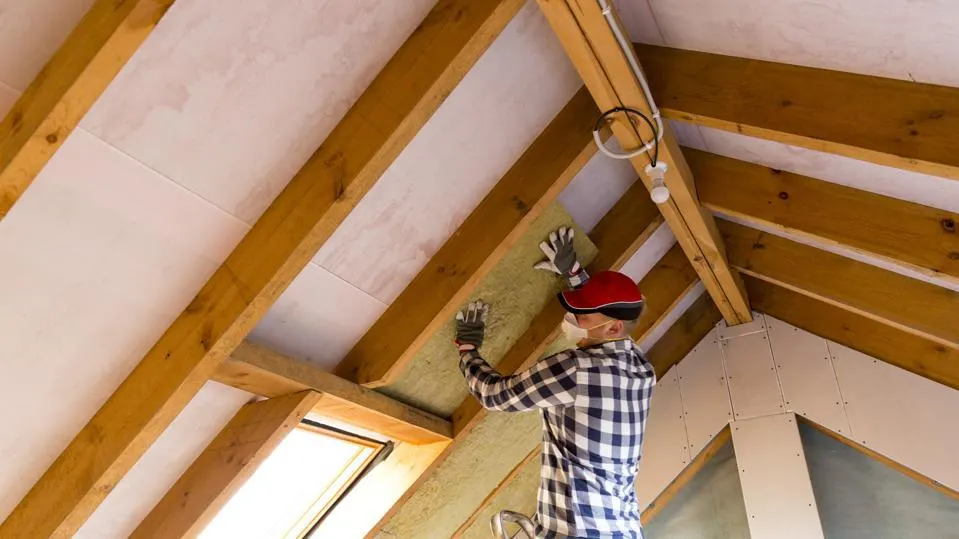Introduction
If you live in a home with a loft or attic, you may have noticed that rooms directly under the roof can become extremely hot in summer and freezing in winter. This is because heat easily escapes through the roof if it is not properly insulated. Room in roof insulation is designed to address this problem by improving thermal efficiency and ensuring comfortable living spaces throughout the year.
Proper insulation not only makes your home more comfortable but also contributes to lower energy bills, reduced carbon footprint, and eligibility for ECO4 grants and energy efficiency schemes. For homeowners in the UK, investing in loft insulation, attic insulation, or room in roof insulation is one of the most cost-effective ways to improve home energy efficiency.
What is Room in Roof Insulation?
Room in roof insulation refers to the process of insulating living spaces that are built directly under a pitched roof. Unlike traditional loft insulation, which is installed on the floor of the loft, room in roof insulation is installed between or under the roof rafters. This ensures that the entire roof space becomes part of the insulated envelope, keeping rooms warmer in winter and cooler in summer.
There are two main approaches:
- Warm roof insulation – insulation is installed above the ceiling and between rafters.
- Cold roof insulation – insulation is installed at ceiling level while the roof space remains unheated.
Benefits of this type of insulation include reducing heat loss, improving comfort, and enhancing the overall energy efficiency of your home.
Related keywords: pitched roof insulation, warm roof insulation, roof cavity insulation.
Benefits of Room in Roof Insulation
- Energy Savings
Heat naturally rises and escapes through uninsulated roofs. Proper insulation helps retain warmth, meaning your heating system uses less energy. This translates into lower energy bills and reduced environmental impact. - Enhanced Comfort
Rooms in roof spaces often experience uneven temperatures. With room in roof insulation, these rooms maintain a more consistent and comfortable temperature all year round. - Eligibility for ECO4 Grants
Under the ECO4 scheme, homeowners can receive support for energy-efficient home improvements. Installing room in roof insulation may make you eligible for grants or financial incentives, reducing the cost of the project. - Environmental Benefits
Improving insulation reduces the amount of energy needed to heat your home, which in turn decreases your carbon footprint.
Related keywords: energy-efficient homes, ECO4 insulation grants, reduce heating bills, carbon reduction.
Types of Room in Roof Insulation
Choosing the right insulation material is crucial. Here are the most common types used in the UK:
- Rigid Board Insulation
These are solid panels placed between rafters or on top of ceilings. They provide excellent thermal resistance and are easy to handle. - Spray Foam Insulation
Spray foam expands to fill gaps and crevices, creating a complete airtight barrier. It is highly effective but must be applied by certified installers. - Mineral Wool Insulation
This includes rock wool and glass wool. It is fire-resistant, soundproof, and provides excellent thermal performance.
Each type has pros and cons. Rigid boards are durable, spray foam is highly efficient, and mineral wool is eco-friendly and easy to install.
Related keywords: loft insulation types, thermal insulation materials, eco-friendly insulation.
Installation Process
Installing room in roof insulation requires careful planning and execution. Here’s a general overview:
- Assessment of Roof Space – A professional will check your roof structure and determine the insulation requirements.
- Selection of Insulation Material – Choose between rigid boards, mineral wool, or spray foam based on your budget, performance needs, and ECO4 eligibility.
- Installation – The insulation is placed between rafters or on top of the ceiling. Proper sealing is critical to prevent gaps and ensure maximum efficiency.
- Finishing – Once insulation is installed, plasterboard or other ceiling materials are replaced to maintain room aesthetics.
DIY installation is possible but not recommended for spray foam. Hiring ECO4-approved installers ensures compliance with safety standards and eligibility for grants.
Related keywords: room in roof insulation installation, insulation experts UK, ECO4-approved installers.
Costs and Savings
The cost of room in roof insulation depends on factors such as the type of insulation, roof size, and professional fees. Typical costs in the UK:
- Rigid board insulation: £15–£25 per m²
- Spray foam insulation: £30–£50 per m²
- Mineral wool insulation: £10–£20 per m²
Although the upfront cost may seem high, the savings on heating bills usually pay off within a few years. Combined with ECO4 grants, the investment becomes even more attractive.
Related keywords: insulation cost UK, savings with insulation, payback period room in roof insulation.
Common Mistakes to Avoid
- Incorrect Thickness or Material – Using thin insulation or low-quality materials can reduce effectiveness.
- Poor Sealing – Gaps allow heat to escape and reduce energy efficiency.
- Hiring Uncertified Installers – Non-certified professionals may not follow ECO4 standards, affecting grant eligibility.
Always choose ECO4-approved installers and high-quality insulation materials to ensure maximum benefits.
Related keywords: insulation mistakes, roof heat loss, certified installers UK.
Summary Table
| Feature | Benefit | Related Keywords |
|---|---|---|
| Energy Efficiency | Lower heating bills, retain warmth | loft insulation, attic insulation |
| Comfort | Consistent room temperature | pitched roof insulation, warm roof |
| ECO4 Eligibility | Qualify for grants and support | ECO4 grants, energy-saving insulation |
| Types of Insulation | Rigid boards, spray foam, mineral wool | loft insulation types, thermal insulation |
| Installation Tips | Proper sealing and certified installers | ECO4-approved installers, insulation experts |
Conclusion
Room in roof insulation is one of the most effective ways to improve home comfort, reduce energy bills, and qualify for ECO4 grants. Whether you choose rigid board, spray foam, or mineral wool insulation, investing in this upgrade will provide long-term benefits for your home and the environment. Proper installation and quality materials ensure optimal results and maximum efficiency.
Frequently Asked Questions
Find answers to commonly asked questions about our products and services.
